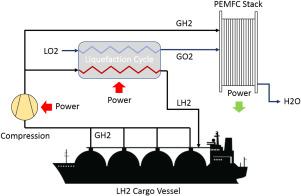当前位置:
X-MOL 学术
›
Energy Rep.
›
论文详情
Our official English website, www.x-mol.net, welcomes your feedback! (Note: you will need to create a separate account there.)
A comprehensive evaluation of a novel integrated system consisting of hydrogen boil-off gas reliquifying process and polymer exchange membrane fuel cell using exergoeconomic and Markov analyses
Energy Reports ( IF 5.2 ) Pub Date : 2021-12-30 , DOI: 10.1016/j.egyr.2021.12.014 Armin Ebrahimi 1 , Bahram Ghorbani 2 , Mostafa Delpisheh 3 , Mohammad Hossein Ahmadi 4
Energy Reports ( IF 5.2 ) Pub Date : 2021-12-30 , DOI: 10.1016/j.egyr.2021.12.014 Armin Ebrahimi 1 , Bahram Ghorbani 2 , Mostafa Delpisheh 3 , Mohammad Hossein Ahmadi 4
Affiliation

|
The price of constructing hydrogen generation units is very high and sometimes it is not possible to build them in the desired location, so the transfer of hydrogen from the hydrogen generation system to the units that need it is justified. Since the storage of hydrogen gas needs a large volume and its transportation is very complex, so if hydrogen is stored in liquid form, this problem can be resolved. In transporting liquid hydrogen (LH) over long distances, owing to heat transfer to the environment, the LH vaporizes, forming boil-off gas (BOG). Herein, in lieu of only reliquifying the BOG, this study proposes and assesses a system employing the BOG partially as feed for a novel liquefaction process, and also the remaining utilized in a proton exchange membrane fuel cell (PEMFC) to generate power. Using the cold energy of the onsite liquid oxygen utility of the LH cargo vessel, the mixed refrigerant liquefaction cycle is further cooled down. In this regard, by using 130 kg/h BOG as input, 60.37 kg/h of liquid hydrogen is produced and the rest enters PEMFC with 552.7 kg/h oxygen to produce 1592 kW of power. The total thermal efficiency of the integrated system and electrical efficiency of the PEMFC is 83.18% and 68.76%, respectively. Regarding the liquefaction cycle, its specific power consumption (SPC) and coefficient of performance (COP) were achieved at 3.203 kWh/kgLH and 0.1876, respectively. The results of exergy analysis show that the exergy destruction of the whole system is 937.4 kW and also its exergy efficiency is calculated to be 58.38%. Exergoeconomic and Markov analyses have also been applied to the integrated system. Also, by changing the important parameters of PEMFC, its optimal performance has been extracted.
中文翻译:

使用运行经济学和马尔可夫分析对由氢气蒸发气体再液化过程和聚合物交换膜燃料电池组成的新型集成系统进行综合评估
建造制氢装置的成本非常高,有时无法将其建造在所需的位置,因此将氢气从制氢系统转移到需要的装置是合理的。由于氢气的储存需要很大的体积,而且运输也很复杂,所以如果氢气以液态形式储存,这个问题就可以解决。在长距离运输液态氢 (LH) 时,由于热量传递到环境中,LH 蒸发,形成蒸发气体 (BOG)。在此,本研究提出并评估了一种系统,该系统部分采用 BOG 作为新型液化工艺的进料,而其余部分则用于质子交换膜燃料电池 (PEMFC) 来发电,而不是仅重新液化 BOG。利用LH货船现场液氧设施的冷能,进一步冷却混合制冷剂液化循环。在这方面,通过使用130 kg/h BOG作为输入,产生60.37 kg/h的液氢,其余的与552.7 kg/h的氧气一起进入PEMFC,产生1592 kW的电力。集成系统的总热效率和PEMFC的电效率分别为83.18%和68.76%。在液化循环方面,其比功耗(SPC)和性能系数(COP)分别达到3.203 kWh/kgLH和0.1876。火用分析结果表明,整个系统火用破坏量为937.4kW,计算火用效率为58.38%。 Exergoeconomic 和马尔可夫分析也已应用于集成系统。此外,通过改变PEMFC的重要参数,获得了其最佳性能。
更新日期:2021-12-30
中文翻译:

使用运行经济学和马尔可夫分析对由氢气蒸发气体再液化过程和聚合物交换膜燃料电池组成的新型集成系统进行综合评估
建造制氢装置的成本非常高,有时无法将其建造在所需的位置,因此将氢气从制氢系统转移到需要的装置是合理的。由于氢气的储存需要很大的体积,而且运输也很复杂,所以如果氢气以液态形式储存,这个问题就可以解决。在长距离运输液态氢 (LH) 时,由于热量传递到环境中,LH 蒸发,形成蒸发气体 (BOG)。在此,本研究提出并评估了一种系统,该系统部分采用 BOG 作为新型液化工艺的进料,而其余部分则用于质子交换膜燃料电池 (PEMFC) 来发电,而不是仅重新液化 BOG。利用LH货船现场液氧设施的冷能,进一步冷却混合制冷剂液化循环。在这方面,通过使用130 kg/h BOG作为输入,产生60.37 kg/h的液氢,其余的与552.7 kg/h的氧气一起进入PEMFC,产生1592 kW的电力。集成系统的总热效率和PEMFC的电效率分别为83.18%和68.76%。在液化循环方面,其比功耗(SPC)和性能系数(COP)分别达到3.203 kWh/kgLH和0.1876。火用分析结果表明,整个系统火用破坏量为937.4kW,计算火用效率为58.38%。 Exergoeconomic 和马尔可夫分析也已应用于集成系统。此外,通过改变PEMFC的重要参数,获得了其最佳性能。


























 京公网安备 11010802027423号
京公网安备 11010802027423号